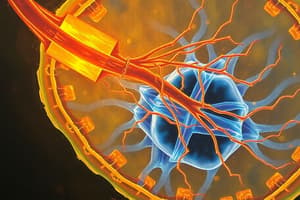Podcast
Questions and Answers
The energy available in food is used to make an energy-rich compound called?
The energy available in food is used to make an energy-rich compound called?
ATP
First step in releasing the energy of glucose in the cell is known as ____________________.
First step in releasing the energy of glucose in the cell is known as ____________________.
glycolysis
The process that releases energy from food in the presence of oxygen is _____________________.
The process that releases energy from food in the presence of oxygen is _____________________.
cellular respiration
The net gain of energy from glycolysis is ___________.
The net gain of energy from glycolysis is ___________.
Because fermentation takes place in the absence of oxygen, it is said to be _______________.
Because fermentation takes place in the absence of oxygen, it is said to be _______________.
The Krebs cycle takes place within the __________.
The Krebs cycle takes place within the __________.
The electron transport chain uses the high-energy electrons from the Krebs cycle to __________.
The electron transport chain uses the high-energy electrons from the Krebs cycle to __________.
A total of 36 molecules of ATP are produced from 1 molecule of glucose as a result of _____________________.
A total of 36 molecules of ATP are produced from 1 molecule of glucose as a result of _____________________.
During heavy exercise, the buildup of lactic acid in muscle cells results in ___________.
During heavy exercise, the buildup of lactic acid in muscle cells results in ___________.
What is a calorie?
What is a calorie?
How do cells use a high-calorie molecule such as glucose?
How do cells use a high-calorie molecule such as glucose?
How is glucose changed during glycolysis?
How is glucose changed during glycolysis?
What products are produced as a result of glycolysis?
What products are produced as a result of glycolysis?
What is the chemical equation for cellular respiration?
What is the chemical equation for cellular respiration?
Name the compounds of the chemical equation for cellular respiration.
Name the compounds of the chemical equation for cellular respiration.
How is NAD+ involved in the products of glycolysis?
How is NAD+ involved in the products of glycolysis?
What happens to a cell's NAD+ when large numbers of high-energy electrons are produced in a short time?
What happens to a cell's NAD+ when large numbers of high-energy electrons are produced in a short time?
Which two compounds react during fermentation? Which of these passes high-energy electrons to the other?
Which two compounds react during fermentation? Which of these passes high-energy electrons to the other?
Write equations to show how lactic acid (1) fermentation compares with alcoholic fermentation (2).
Write equations to show how lactic acid (1) fermentation compares with alcoholic fermentation (2).
How are fermentation and cellular respiration similar? What is the main difference between their starting compounds?
How are fermentation and cellular respiration similar? What is the main difference between their starting compounds?
What happens during the Krebs cycle?
What happens during the Krebs cycle?
What happens to the high-energy electrons generated during the Krebs cycle?
What happens to the high-energy electrons generated during the Krebs cycle?
How is ATP synthase involved in making energy available to the cell?
How is ATP synthase involved in making energy available to the cell?
When runners race for about 20 minutes, how do their bodies obtain energy?
When runners race for about 20 minutes, how do their bodies obtain energy?
Flashcards are hidden until you start studying
Study Notes
Energy in Food
- Food energy is converted into ATP, a key energy-rich compound utilized by cells.
Glycolysis
- The initial process of glucose energy release occurs through glycolysis.
- Glycolysis breaks glucose into two 3-carbon molecules called pyruvic acid.
- The net gain from glycolysis is 2 ATP molecules.
Cellular Respiration
- Cellular respiration is the process that extracts energy from food, requiring oxygen.
- A total of 36 ATP molecules can be produced from one glucose molecule during cellular respiration.
Fermentation
- Fermentation occurs in the absence of oxygen, classified as anaerobic.
- During fermentation, high-energy electrons from NADH are passed to pyruvic acid.
Krebs Cycle
- The Krebs cycle occurs within the mitochondrion and processes pyruvic acid, releasing carbon dioxide and energy.
- High-energy electrons from the Krebs cycle are utilized to convert ADP into ATP.
Electron Transport Chain
- The electron transport chain harnesses high-energy electrons to create ATP.
Oxygen Debt
- Heavy exercise leads to lactic acid buildup in muscle cells, resulting in oxygen debt.
Caloric Energy
- A calorie is defined as the energy needed to raise the temperature of 1 gram of water by 1 degree Celsius.
- Cells break down glucose, releasing stored energy gradually.
Chemical Equations
- The chemical equation for cellular respiration is 6O2 + C6H12O6 → 6CO2 + 6H2O + Energy, involving oxygen and glucose as reactants.
NAD+ and Electron Transfer
- NAD+ plays a role in glycolysis by picking up high-energy electrons.
- As high-energy electrons accumulate, cells may reach a saturation point for NAD+.
Comparison of Fermentation Types
- Lactic acid fermentation: glucose → lactic acid.
- Alcoholic fermentation: glucose → alcohol + CO2.
- Both types begin with glucose as a reactant.
Similarities and Differences of Fermentation and Cellular Respiration
- Both processes break down glucose to release energy and initiate with glycolysis.
- Primary distinction: Cellular respiration requires oxygen, while fermentation does not.
ATP Synthase Function
- ATP synthase facilitates energy production by allowing hydrogen ions to pass through, converting ADP into ATP.
Energy Use During Exercise
- Initial energy in a race is derived from stored ATP and lactic acid fermentation.
- After approximately 20 minutes, the body switches to cellular respiration for ATP production from stored carbohydrates.
Studying That Suits You
Use AI to generate personalized quizzes and flashcards to suit your learning preferences.




